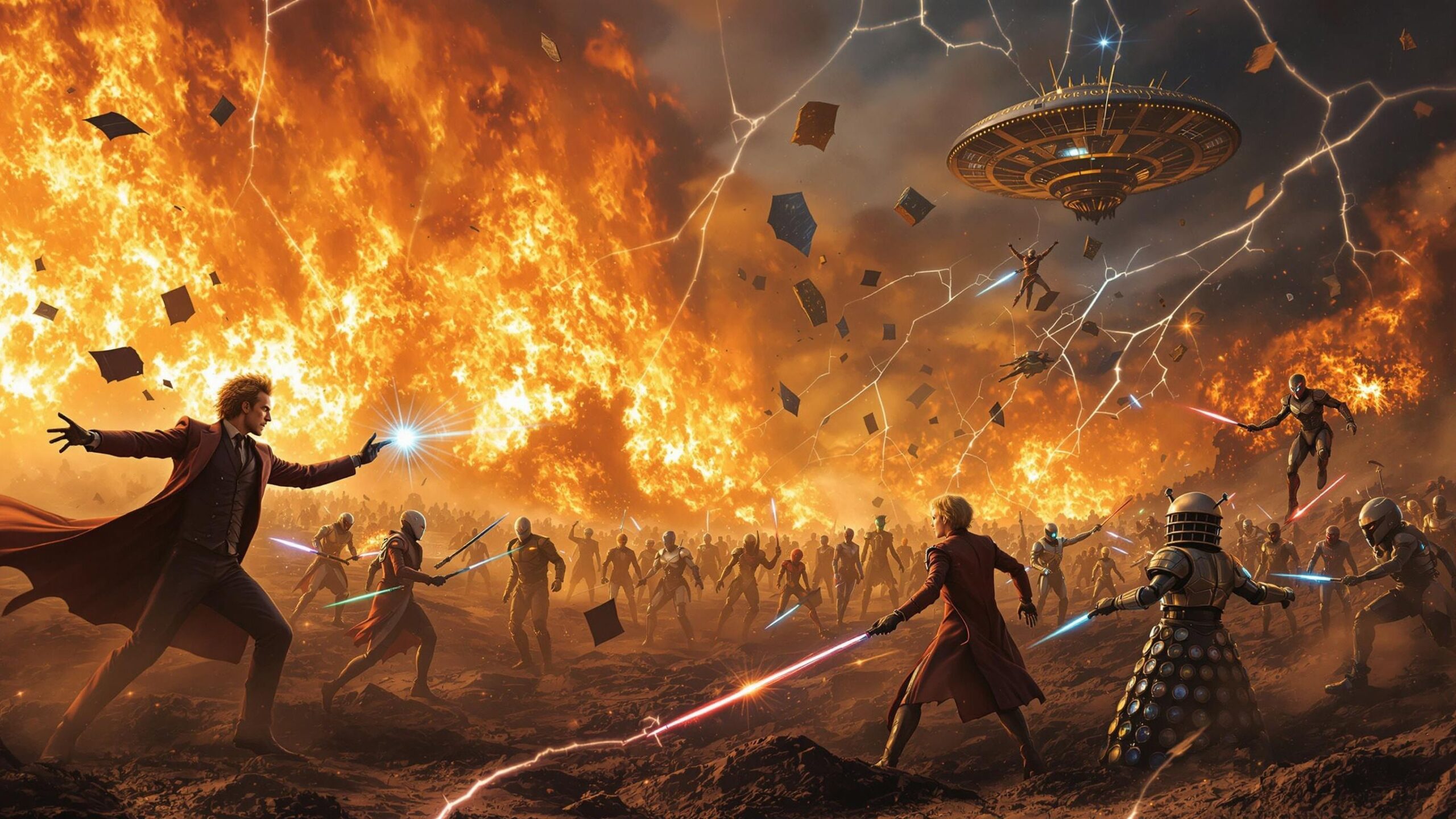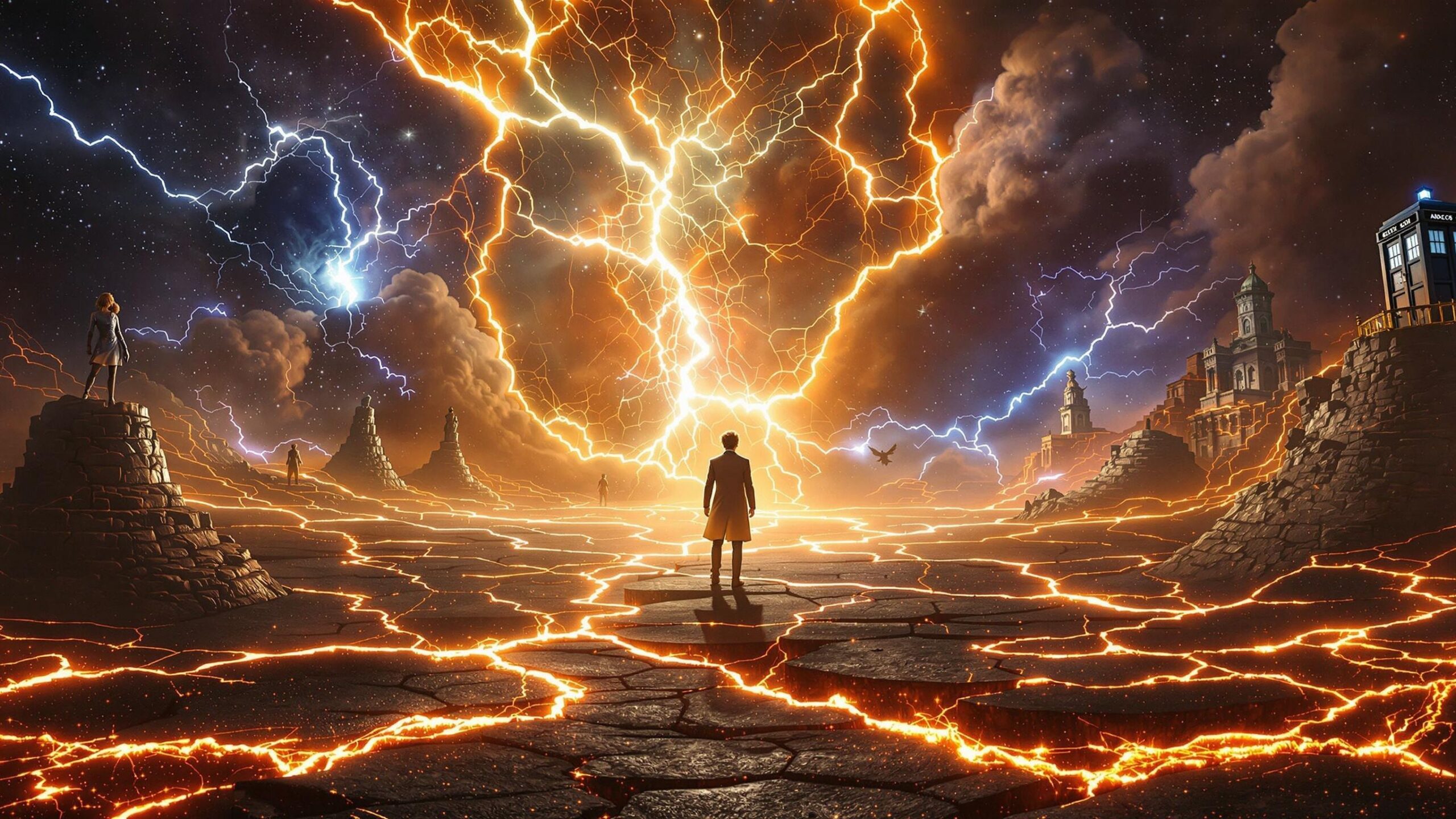While Doctor Who often dazzles us with fantastical creatures, time-travel adventures, and moments of hope, it also knows how to chill us to the bone. Some of the series’ most unforgettable stories aren’t the ones filled with explosions or Dalek invasions, but those that linger in your mind like a whisper in the dark. These haunting episodes don’t just scare us in the moment—they stay with us because of their themes, atmosphere, and psychological horror. Whether through the eerie stillness of a shadow, the loneliness of an abandoned space station, or the philosophical terror of lost identity, Doctor Who has mastered the art of fear in many forms. Here are ten episodes that left us haunted long after the credits rolled.
#10: The Impossible Planet / The Satan Pit (2006)
This two-parter, starring the Tenth Doctor and Rose, is a slow-burn descent into cosmic horror. Set on a deep-space research station orbiting a black hole, the crew discovers an ancient evil imprisoned beneath the planet’s surface. The villain claims to be the Devil, but what makes this episode terrifying is not whether he is or isn’t. It’s the unsettling idea that there may be forces older and darker than Time Lords and that some evil transcends even the Doctor’s understanding. The Ood, seemingly gentle servitors, become possessed and murderous, their glowing red eyes a chilling contrast to their usual docile expressions. The bleak environment, eerie sound design, and existential dread combine to create an unforgettable atmosphere.
#9: Tooth and Claw (2006)
Set in Victorian Scotland, this episode blends period drama with intense werewolf horror. As the Doctor and Rose arrive at a remote estate hosting Queen Victoria, they discover a terrifying alien creature that uses a human host to transform during the full moon. The werewolf sequences are shot with spine-tingling tension, and the concept of an alien life form passing through generations to infect the royal bloodline adds a layer of mythological dread. The candlelit halls and fog-covered landscapes contribute to the episode’s gothic horror tone. What lingers, however, is the unsettling idea that the British monarchy may have been cursed or genetically altered forever by this encounter.
#8: The Waters of Mars (2009)
One of David Tennant’s darkest outings as the Doctor, The Waters of Mars is set on Bowie Base One, the first human colony on Mars. When water starts seeping through the base and transforming its crew into zombie-like creatures with cracked faces and streaming eyes, the horror becomes immediate and visceral. But what makes the story haunting is the Doctor’s reaction. Knowing the base is doomed and that its destruction is a fixed point in time, he decides to change history. His temporary god complex is both powerful and deeply disturbing. The tragic ending—and the Doctor’s realization of his arrogance—leaves a bleak emotional impact that resonates more than any jump scare.
#7: Midnight (2008)
Few episodes strip the Doctor down to his core as effectively as Midnight. On a tourist shuttle traveling across a hostile planet, the Doctor becomes trapped with a group of strangers as an invisible entity invades the ship. The creature never shows itself—it only mimics the passengers until it takes over their speech entirely. The real terror isn’t the monster; it’s the way the humans quickly descend into suspicion, fear, and violence. The claustrophobic setting, intense performances, and lack of any clear explanation for the entity’s origin all add to the psychological horror. It’s an unnerving reminder of how fragile civilization becomes in the face of the unknown.
#6: Silence in the Library / Forest of the Dead (2008)
These episodes introduce the Vashta Nerada, creatures that live in shadows and devour flesh in seconds. Their motto is simple and terrifying: “Stay out of the shadows.” The Doctor and Donna arrive in a massive, abandoned library, where shadows move on their own and the dead speak through data echoes. Donna is trapped in a simulated world, forced to question her own reality. The mix of body horror, eerie visuals, and the existential fear of being trapped in a digital afterlife make this two-parter one of Doctor Who’s most philosophically disturbing stories. It also marks the first appearance of River Song, who adds emotional complexity to the Doctor’s future and past.
#5: Hide (2013)
This seemingly straightforward ghost story unfolds into something far stranger and more emotional. The Doctor and Clara visit a haunted mansion where a psychic and a war veteran are investigating a spirit. Through a series of time-travel experiments, the Doctor learns that the ghost is actually a time traveler trapped in a pocket universe, desperately calling for help. The haunting aesthetic—complete with thunderclaps, flickering lights, and shadowy figures—creates traditional horror ambiance. But the real terror comes from the idea of being lost forever in an isolated dimension. The resolution, centered on love and rescue, adds emotional depth that stays with you long after the scares fade.
#4: The Girl in the Fireplace (2006)
One of Steven Moffat’s most emotionally resonant scripts, this episode combines sci-fi and historical romance with a strong dose of haunting melancholy. The Doctor keeps stepping into 18th-century France through time windows aboard an abandoned spaceship, where clockwork androids are stalking Madame de Pompadour. The automatons themselves are chilling—masked, silent, and relentless in their pursuit. But it’s the emotional weight of the Doctor’s relationship with Reinette, and the cruel timing of his final return, that truly haunts. The episode explores themes of time, memory, and loss in a way that few others have, making it as heartbreaking as it is eerie.
#3: The Empty Child / The Doctor Dances (2005)
Set during the London Blitz, this two-parter introduces one of the most iconic creepy catchphrases in Doctor Who history: “Are you my mummy?” A mysterious child in a gas mask wanders the bombed streets, spreading a terrifying plague that transforms others into copies of itself. The horror lies not only in the body horror and creepy visuals but also in the psychological weight of war, abandonment, and disease. The story masterfully balances horror and hope, ending on a rare but cathartic note of universal survival. Still, the haunting image of a gas-masked child asking for his mother remains deeply embedded in fan memory.
#2: Listen (2014)
This slow-burning, philosophical tale explores the fear of being watched when no one is there. The Twelfth Doctor becomes obsessed with the idea that everyone has had the same nightmare—a presence hiding just out of sight. The episode takes viewers through orphanages, childhood memories, and even the Doctor’s own traumatic past. What makes it so chilling is its ambiguity. Was there ever anything there? Or is fear itself the monster? The minimalism of the horror—a figure under a blanket, a knocking sound in an empty room—creates an atmosphere of dread that feels personal and primal. It asks disturbing questions with no clear answers, which is perhaps the most haunting thing of all.
#1: Blink (2007)
The definitive Doctor Who horror episode, Blink introduced the Weeping Angels—creatures that can only move when unobserved, sending victims back in time and feeding on their lost potential. Told primarily through the eyes of Sally Sparrow, a woman caught in a time-twisting mystery, the episode combines tight plotting, eerie visuals, and brilliant dialogue into a masterclass of suspense. The Angels’ grotesque design and sudden movements tap into deep-seated fears of being watched or followed. But what makes Blink truly haunting is its emotional resonance: the sense of missed connections, love across time, and the fragility of life. Even years later, fans still flinch at stone statues—and avoid blinking.
The beauty of Doctor Who is its ability to explore darkness through a lens of wonder, fear, and human resilience. These haunting episodes are not just scary because of the monsters or the stakes—they’re scary because they reveal uncomfortable truths. About fear. About identity. About time and memory. And they do it with nuance, intelligence, and just enough horror to make sure you never quite forget them. That’s the essence of a haunting episode—it doesn’t leave when the screen goes dark. It stays with you, echoing in the back of your mind like a voice in the shadows.




